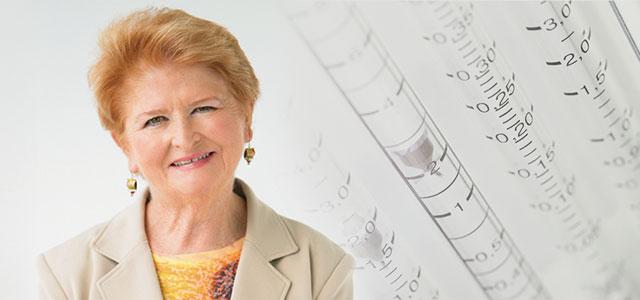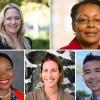
Marylin J. Dodd
AAN Names Marylin Dodd a Living Legend
Marylin J. Dodd – who this year was named a “Living Legend” by the American Academy of Nursing – is best known for her visionary contributions to patient self-care and the science of symptom management. The honor is just the latest in a careerlong string of them, including being a charter member of Sigma Theta Tau’s International Nurse Researcher Hall of Fame and receiving the highly esteemed Episteme Award.
Dr. Dodd’s self-care intervention model provides relevant information, self-care skills and support to patients and families. Tested in numerous clinical trials, the program laid the foundation not only for Dr. Dodd’s oncology colleagues, but for other clinical specialties and international investigators who study symptom management. These include colleagues at UC San Francisco School of Nursing, where, more than two decades ago, Dr. Dodd was instrumental in establishing the internationally renowned Research Center for Symptom Management, with the goal of advancing knowledge in the field of symptom management to improve providers’ practice and patients’ outcomes. Interdisciplinary by both discipline and clinical populations, the center developed a symptom management model that today is used widely by both researchers and clinicians.
Science of Caring spoke with her in September 2015.
SOC: As you look back on your distinguished career, why did you first choose nursing?
MD: I date back to a time when [I was] in the sixth grade, in Vancouver, Canada: women could either be a nurse, secretary or teacher. My father tried to talk me into teaching – teachers have the summer off, and neither of my parents graduated from high school – but there was something about nursing. I went to a diploma hospital program, a three-year program at Vancouver General Hospital, in September 1967, just after my 18th birthday. But by then, times were changing, and I was told I might want a BSN, so I came down to Seattle, where I enrolled in classes at community colleges, local universities and then the University of Washington while I worked full-time at the University of Washington Medical Center, from 3 to 11:30. I wound up graduating in three and a half years. After working for about six months as a staff nurse, a supervisor there told me I should think about a master’s, which I did at the University of Washington from 1973 to 1974.
SOC: How did you come to oncological nursing and research?
MD: In the last quarter of my master’s program, I took a course in death and dying with Jeanne Benoliel (who was the first doctoral graduate from UCSF School of Nursing in 1969). She really had us reflect upon our practice and on life events, things I don’t think I had really processed up to that point. Until then, I had been a coronary care nurse, and I did some thinking about the big transitions for people I’d been privileged to be involved with. And when I began teaching at UW, Jeanne became a friend and mentor; she was very generous about imparting her wisdom, and during this very profound, soul-searching time…I began working in oncology.
I also became really smitten with teaching, but I would need a doctorate for that. I flew around and interviewed with different faculties and schools. At that time, Wayne State had a number of professors I thought I could learn a lot from, so I enrolled.
SOC: How did you come to develop the PRO-SELF program?
MD: While I was at Wayne State, the faculty knew I worked in oncology and would ask me to see family and friends who were going through cancer treatment. Also, a couple of churches sponsored me to oversee two particular families having a rough time managing the side effects of treatment and the symptoms of advanced cancer.
I saw that even those who had been hospitalized for cancer treatment and were discharged home needed to check in with someone who could teach them Nursing 101: when to call a physician, what to do with medication, the basics to manage on their own at home. But I also found that in the main, people were and are reluctant to recontact their doctor or nurse too much, so they’ll sit until they have to go to the emergency room. My questions were: What do they need to learn so they can avoid the ER, and how can families support each other?
I remember working with this young fellow with advanced colorectal cancer. His family – his wife and two small children – were all revolving around his incredible pain. I needed to help them get what they needed: a prescription for the right analgesic; understanding of how to get the prescription filled and take it appropriately; keeping a pain diary. That involved doing a first-rate assessment of what was going on and what information would be helpful.
That was how the self-care seed [and eventually PRO-SELF] was sown: it was informed by my practice. My dissertation wound up being about how to help people with their self-care in managing the side effects of chemotherapy and radiation.
SOC: Why do you think the program has been so successful for so long?
MD: My original intent was to work myself out of a job, to help this family be more secure and make sure they knew how to avoid trading one problem for another – pain for horrible constipation, for example. Over time, though, the need has become more urgent as services like visiting nurses and home health care aides have undergone drastic cutbacks. As the emphasis moved to outpatient care – drive-through chemo – you might have access by phone to a nurse after you leave, but it’s not the same as having someone sitting in your living room.
So that’s why I wrote my book for individuals and families [Managing the Side Effects of Chemotherapy and Radiation Therapy], which had four editions. Today, there is maybe more of a need, because although there is a lot of information out there, there is also a lot of misinformation, and we need to educate people and families about what is credible; we need to help people become educated consumers of what’s on the Internet.
PRO-SELF is now in its eighth generation of randomized clinical trials to see how effective it is in tackling the most distressing and severe side effects of cancer and cancer treatment: pain, mouth sores, neurological pain. These are serious issues, because treatment has become more aggressive. Patients now receive massive doses of radiation or combined radiation and chemotherapy and need to know about things like good oral care – mouthwashes to protect the mucosa, dental care before starting treatment, how to assess your mouth using mirrors. That’s part of why in our clinical trials we’ve been very interdisciplinary – nurses, medical oncologists, radiation oncologists, dentists, pharmacists, statisticians.
SOC: How did this work lead to the UCSF Research Center for Symptom Management in 1994 and, ultimately, the symptom management model?
MD: At the School of Nursing, we were all working with our particular clinical populations and were on a faculty retreat when we talked about how to work together to make greater strides more quickly in our understanding of symptoms. There was a core group who met regularly under the initial leadership of Pat Larson; the group included Susan Janson from pulmonary, Ginger Carrieri-Kohlman for COPD [chronic obstructive pulmonary disease], Chris Miaskowski for pain, Kathy Lee for sleep and fatigue, and eight other faculty. We were trying to address particularly complicated patient problems, and there was some wonderful cross-pollination. Working with these talented faculty members who were so well known for their expertise was a wonderful experience.
But to really make progress, we had to arrive at a common language, which is how we created the model for symptom management. The first circle speaks to assessment of all symptoms and components. The second is about intervention, what you are going to do, when you’re going to do it, who will do it and how frequently. The third cycle is assessing outcomes: did it make a difference in quality of life and in the symptom itself? It’s wonderfully simple and yet elegant.
SOC: Please talk about how you arrived at the idea of symptom clusters.
MD: We had discussed that people don’t usually show up with just one symptom, but often a constellation of symptoms or side effects. Some of the Research Center’s faculty were working with Drs. Bill and Barbara Given at Michigan State, who were beginning to define symptom clusters: two or more symptoms that occur at the same time and are related, so something synergistically may be happening. When these clusters are present, they are a harbinger of greater risk. For example, when the patient is experiencing pain, sleeplessness and depression, the clinician could anticipate greater patient morbidity. Clinicians knew this, but it took us a while to articulate and study these clusters, to understand important ideas, such as what symptom is the primary [one] and, perhaps, driving other symptoms. In our randomized clinical trials now, we try to identify and go after these primary symptoms.
Often pain is the centerpiece, and its effects will ripple out. In Chris [Miaskowski’s] work, we often go after pain or fatigue first, but [addressing the clusters demands that you] think three-dimensionally. What a person is experiencing can be like a double helix, and sometimes we can mobilize interventions in the morning for one thing, and for something else in the afternoon. The idea is to build out the science to do this combination therapy and vary it depending on patient experience.
SOC: Are you satisfied with where we are in managing symptoms? And what’s next?
MD: In most clinical settings, they’re doing their level best to provide the right symptom care. They know we have some science and foundation behind people receiving appropriate analgesics, and antinausea and anticonstipation therapies. Our model for symptom management is a big favorite because it makes a lot of sense to clinicians.
But so much of care these days, particularly cancer care, is outpatient, with 35 people in the waiting room, and there’s rarely enough staffing to help people with self-care. There’s a lot of triaging: what are the three things this woman has to know before she leaves because she’s going home, her husband is picking her up at 5, she’s whacked out on Ativan and so on? Of all the things I can be telling this adult learner about neuropathic pain, what can she possibly retain? That’s why it is really helpful when a family member is there to help hear the instructions and information.
I know some people hand out little pamphlets, various and sundry things to be put in a purse to be referred to later; maybe there’s a little cassette in the waiting room; sometimes a nurse will call in 24 hours. But none of that is as effective as face-to-face, because addressing symptoms needs to be individualized. It can be a huge and complex decision tree, and you can brutalize people with so much information that it’s hardly enlightenment. We’ve gone from saying nothing to this avalanche of information, and I do think people need clinicians to help them through those first phases.
SOC: You still sound as though you remain pretty involved, but how are you spending your days in retirement?
MD: It’s a most enjoyable time, I must tell you, to retire with your health and a little folding money. I’ve been traveling and seeing friends and family I have not seen enough over the years, and we’re all getting up there in age. I also have a garden that is my pride and joy, and it looks like someone actually cares for it now. I help some young faculty who were on my studies and who are now teaching in other universities and striving to get tenure. I do a lot of volunteer work. I do miss my colleagues, who made my life rich and full. And I miss the students who taught me a lot; teaching brought me such joy.
But I saw a whale today. I was standing at my kitchen window, looking out, and once that spout goes up, there’s nothing like it; I saw the back cresting.



